Esodo. (EH-zo-do.) It means “exodus,” but this simple term — like “Fort Sumter” or “potato famine” — is freighted with history and emotion.
When a Venetian refers to the Esodo, he or she is referring to a Gordian convolution of elements of which the Mother Strand which is knotting up everything else is this: Everybody’s leaving. Not all at once, obviously, but at a fairly steady rate of 1,500 a year. This has been going on for decades.
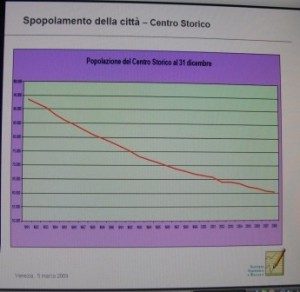
In 55 years (1951-2006), the “historic center” (“postcard Venice,” as I put it) has lost 65 percent of its population. It shrank from 171,808 residents to 63,925. At this writing, the population is 60,311 and still falling. I’ll pause to let that sink in.
If “exodus” seems to be a dramatic word, calling to mind haggard refugees plodding toward the horizon, the reality it connotes is not less dramatic, and potentially fatal to the city’s future. “‘Save Venice’ is passe’,” professor Fabio Carrera, a Venetian, told me, only slightly in jest — ” We need ‘Save the Venetians.'”
The reason the city doesn’t look like the desolate wasteland it is becoming is partly because the casual visitor doesn’t miss what he/she/they never knew. If you’re just walking around for a day, everything looks fine. Self-suggestion is a powerful force, and if you believe that Venice is inhabited by Venetians, you probably won’t notice much to contradict that idea, even though it’s mostly tourists who are filling up the empty spaces, both on the streets and in the apartments.
Economic pressures generated and intensified by the steady increase in tourism (3 per cent a year, till this year), have conspired to cause something resembling forced migration. Venetians have been packing up and moving out for many reasons: Lack of jobs here (businesses closing, even as you read this, due to rents which keep rising, and competitivity which keeps falling), the exaggerated cost of housing, the general cost of living, and even the nature of ordinary daily life (“fatiguing,” demanding,” “inconvenient,” even diehard Venetians will admit).
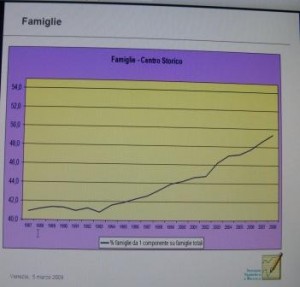
To consider each of these points more closely, let’s look at the last first. Living in Venice, beautiful and fascinating as it may be, is not for everyone. Living here is a vocation, like being a priest, and it too involves sacrifices (and rewards). Considering how heavy — and even impossible — some of those sacrifices have come to be, I can understand why the city can’t keep its kids at home. Not everyone wants to walk five miles a day shlepping the shopping, wedging themselves and their kids onto vaporettos crammed with tourists and their inconceivable luggage, paying prices for even the simplest items which you know cost half as much on the mainland.
Leaving Venice — apart from being carried out in a pine box — has usually meant a move to the mainland towns. First it was Mestre and Marghera, then the territory of Venetian exiles expanded to a series of smaller sub- and exurbs such as Zelarino, Chirignago, and Favaro Veneto. I think of it as Venice’s “near abroad,” the way Russia refers to its former republics. Except some of these settlements were mere wide spots in the country roads winding through fields till the Esodo began.
Mestre and Marghera have been part of the municipal entity known as the Comune di Venezia since 1926. In 1951, the proportion of inhabitants between Venice and its mainland component was 55:21. In 2006, it was 23:66.
Second point: Cost of housing and of living. Here again, the pressure of tourism works against the city’s ultimate well-being (as a city, I mean, not as a theme park). There is very little residential space for rent (for many reasons, one of which is laws which heavily favor the tenant), and the passion which non-Venetians have for buying a place here has led to phenomenal real estate speculation, pushing prices so high a normal Venetian can’t even spell them, much less pay them. The Giudecca has replaced Tuscany as your well-off Briton’s favorite Italian place for a second home.
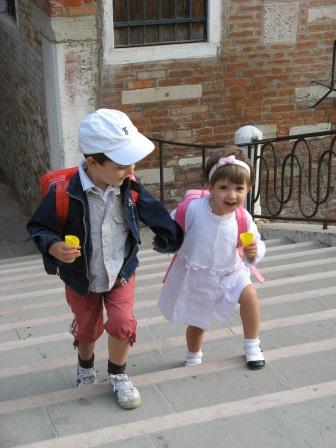
Depending on the neighborhood, a modest dwelling can cost up to $5,000 per square meter (or 10 square feet). For the same amount of money (assuming you might have that much), or even less, you could get a place on the mainland that was multiple times larger, in better condition, with an elevator, and a garage, and a garden, and so on. If you’re a young family on a budget, you’re going to delete “romance” from your list of domestic requirements and go west.
And finally, the first point: Lack of jobs. Until the middle of the last century, Venice was a city that worked. The Arsenal was still going strong, repairing ships; the colossal Molino Stucky was making pasta, from grinding the wheat to boxing and shipping the final product; there were 20 printing presses; there were factories in Venice and on the Giudecca making cigarettes, cotton thread, asphalt, clocks, pianos, fireworks, beer, and luxury fabrics. I’m probably leaving something out. If you needed work, you’d have had to stay in bed to avoid finding it.
The cost of everything has not only forced out families, but also businesses. They keep closing, or moving, taking their jobs with them. Now, some 20,000 people commute to work on the mainland every morning.
So while “esodo” is what everybody calls it, I’d compare it more to a Class III hemorrhage, caused perhaps by several events but which, taken together, damage the vital functions and left unaddressed will probably kill you.
I know a number of ex-residents — they would still call themselves “Venetians” — who have moved to Mestre. (If you’re a native of Mestre, you’re referred to as a “Mestrino/a.” If you go anywhere outside the Veneto region, though, you will almost certainly tell people you’re from Venice. Technically, it’s not a lie, but your listener will be imagining you in a gondola and not stuck in traffic on the way to the airport.)
The older these exiles are, the less willing they were to make this move. One of them, a guy I know who belongs to a boat club over there, makes a point of rowing over here with his buddies as often as he can.
They stopped in the canal outside one afternoon and rang my doorbell. We had a little schmooze, but he ignored his three companions’ pleas to get going because he had to — HAD TO — show me something. Because his grandparents used to live in our building, and when he was born — he dragged me around the corner — his grandfather immediately took him to this very canal (he showed me the very steps going down into the very water) and dunked him three times. “This red bandanna,” he pointed to his neckerchief, “means I’m from Castello.” His friends were rolling their eyes, but to him it was something utterly crucial about him, about the city, about the world the way it used to be, a world that doesn’t and can’t and won’t ever exist on the mainland.
I’ve met ex-Venetians who come over from Mestre on Sunday afternoon just to stroll around, just to be here. Like going back to the old home place. On a personal level, it is pure pathos, which doesn’t primarily mean “sad,” it means “suffer.” I don’t know if I’ve ever heard a transplanted Venetian say, “Life is so much better since we left Venice.” I have heard some say, “We really, really miss it.” The emotional reality of this erases much of the importance of factors such as cost of living, crowded vaporettos, and all those other drawbacks I mentioned above.
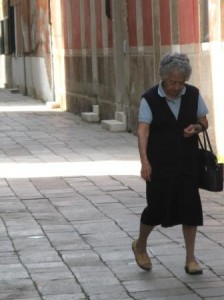
The city government is not oblivious to what’s going on. There are spasmodic attempts to get a grip on some appendage of this monster, and a recent recalculation shows that the departures have slowed, if not stopped. New apartments built or renovated to be made available at advantageous prices to Venetians was an excellent idea, then it was discovered that there were Venetians buying them in order to re-sell them. Jobs? Nobody seems to know where more might be found. I think I saw one around here the other day, but I can’t remember where.
I sometimes wonder what it would be like to be the mayor of Venice and go abroad to some big international conference of mayors. And someone asks, “So, how are things in your city?” (I overlook his probable first response which would be “Fine, except that the people are morons.”) I imagine him saying “Fine,” period. Or maybe, “Well, could be better.” Or maybe, “We’re evaluating some exciting new projects,” or however mayors phrase it.
It would be much harder to have the nerve to admit, “There are a lot of great things about my city, except that nobody can live there. I’m mayor of a city in which it is becoming literally impossible to live.” What response could anyone give to that statement? It would be like asking a ship’s captain about his vessel and hearing him say, “She’s in great shape, except for that large hole in the hull.” Nor would it make much sense for him to say, in effect: “Hey! At least we’re still floating!”
It bears some thinking about. In fact, now that this radical thought has occurred to me, it’s going to be bothering me a lot.

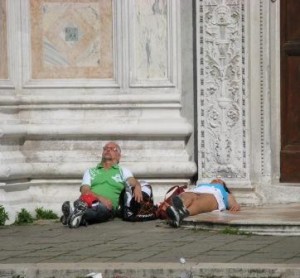
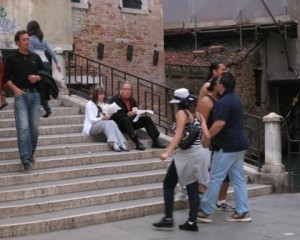
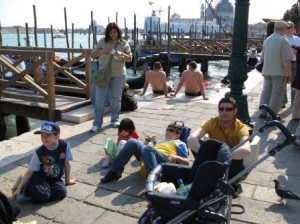
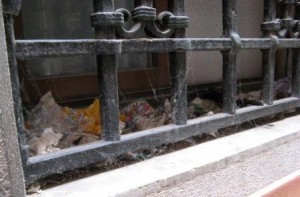
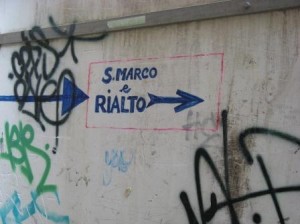 Street vendors — insistent and vaguely disturbing. Which leads to Point Two.
Street vendors — insistent and vaguely disturbing. Which leads to Point Two.